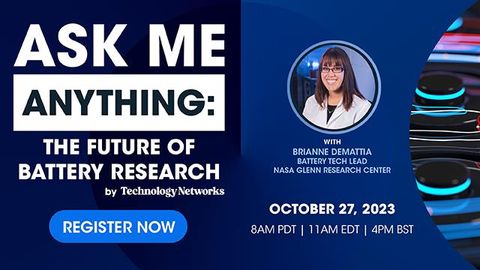Discovering the Future of Batteries in Space and Aeronautics With Brianne DeMattia
Batteries are a ubiquitous part of life on Earth, but what role do they play in space and next-generation aircraft?

Complete the form below to unlock access to ALL audio articles.
Brianne DeMattia is a research electrical engineer at NASA Glenn Research Center, where she researches battery failure analysis for next-generation battery development. Currently, her primary focus lies in advancing battery development for electrical aircraft concepts.
Technology Networks invited Brianne DeMattia to an Ask Me Anything session to answer your questions about the future of battery research. These are just some of the questions that we asked Brianne, click below to watch the full AMA.
Lucy Lawrence (LL): How did you become a research electrical engineer at NASA?
Brianne DeMattia (DM): My dad actually works at NASA Glenn as well and has been working here for 36 years as an electrical engineer working on power systems for space. As a kid, I thought that was so cool. I wasn't sure that NASA was necessarily the way that I wanted to go, but I knew that engineering overall was for me. I loved math and science and experimentation and being able to learn new things and try new things. When I was in high school, I realized I was interested in chemistry, biology and physics, and started doing extracurricular clubs based on those activities.
Once I started college, I decided on chemical engineering as my direction. Research electrical engineer is my official title at work, but technically, I have a chemical engineering background. One of the great things at the college that I went to was that in your first year at the engineering school, there was an “intro to engineering” course, which lasted an entire semester. It was great for people who knew they wanted to do engineering but didn’t know which particular field to go into. Two or three weeks were spent on each different engineering discipline, so it gave a small taste of each discipline. For people who want to go into engineering, I would recommend that kind of course, or shadowing engineers, even just for a day. That will really give you a better idea of what the job looks like, and whether it's something that you're interested in.
LL: Could you give us a brief overview of how you use battery technology in space exploration at NASA?
DM: We have two prongs of research and development (R&D) at NASA – most people forget about the aeronautics side, because the space side is admittedly far cooler. We have battery R&D in both of those areas. For the past 20 years, the focus of our battery research has been lithium-ion battery technology. Lithium-ion batteries are rechargeable batteries that are almost ubiquitous now. Their charge can last a long time, but not as long as we would like it to. Therefore, a big research area is battery longevity – improving them and making them last longer.
We have a lot of applications, especially in our space department, where there are no other energy sources. Here on earth, you can plug something in and get power from the energy grid almost anywhere, or failing that, you can access environmental sources of power, such as solar power.
However, there are some places – for example, deep space or parts of the International Space Stations’ (ISS) rotation around the Earth (when the Earth is between the space station and the sun) – where even solar power cannot be accessed. In those cases, batteries are essential.
Every one of those applications is different, so every battery that we have for those applications needs to function very differently and requires a different battery design.
In the aeronautics department, a major application of batteries is electric aircraft, in order to replace jet-fueled aircraft. For almost every mission or application that we have, there's a battery somewhere.
LL: How do extreme temperatures in space affect batteries?
DM: The basic answer is “a lot”. The more detailed answer is that the kinetics of how the reactions occur within the battery are significantly affected by swings in temperature. Kinetics are severely limited in colder temperatures. So, we either have to engineer around the battery to keep it warm (our usual approach), or we have to research how to improve the performance at lower temperatures. One component of the battery is a liquid electrolyte, which allows the lithium ions to flow back and forth. That flow is severely limited at low temperatures. However, different kinds of additives can improve the flow, which is a large area of our current research.
We also have significant problems in high temperatures and in environments with extreme temperature swings – for example, from −250 oC up to +450 oC on the surface of Venus.
The battery technologies for those need to be unique because a battery that can survive in a lunar or colder environment will not survive on Venus and vice versa.
Some of the problems can be solved by chemistry and being able to modify the battery chemistry to function at those temperatures. However, a lot of the problems are engineering problems – discovering how to engineer controls around the battery to keep it warmer or keep it colder and keep it in its optimum temperature range.
LL: How does NASA ensure the safety of batteries in space missions?
DM: We have a large group at the Johnson Space Centre that works entirely on battery safety. Every battery that needs to be operated and flown gets designed and tested at the Johnson Space Centre. The biggest safety tests we’ve been doing recently involve putting the batteries through all different kinds of abuse testing to explore their reactions and discover what we need to engineer around them to contain any kind of catastrophic failure.
One of the more significant safety problems that has come up over the past decade or so – and a major focus for us – has been thermal runaway propagation. Thermal runaway happens when side chemical reactions start to occur in the cell as a result of heat being applied to the lithium-ion cell, mistreatment, or a manufacturing defect. These reactions are exothermic, meaning they give off heat (Figure 1). As the stray reactions continue, they give off more heat, and that heat feeds into the next reaction, and so forth. Eventually, this turns into a self-sustaining thermal runaway. One single cell is not a huge issue for thermal runaway, but when one cell in a large battery with multiple cells enters thermal runaway, the propagation of that thermal runaway can heat up the next cell and cause it to enter thermal runaway as well. This turns into a very dangerous game of dominoes, with heat and fire out of control, and preventing it is a key focus of safety research.

Figure 1: Thermal runaway in battery cells. Credit: Technology Networks, adapted from Feng et al, 2018.
The Johnson Space Centre does all that safety research for us, they are wonderful. They have written the handbook for all the safety tests that must be done on cells and batteries that we buy and design to ensure safety on any space mission that we have, whether it's manned or unmanned. As we progress with aeronautical research, all those tests and efforts will need to be repeated to create a safe battery environment for electric aircraft too.
LL: How do astronauts charge their devices and equipment in space?
DM: We’ll use the ISS as an example, but this goes for other space vehicles too. The space station has both solar panels and batteries on board. Under normal circumstances, when the space station is in view of the sun, the solar panels are powering both the space station and charging the batteries that are onboard. So then when the ISS goes behind the Earth and is hidden from the sun, the batteries power the space station. Those batteries are also recharging any other batteries that are on board, such as the batteries in the extra-vehicular activity suit and the astronaut suit. The astronauts need battery-powered tools when they go out on their sorties. These have a couple of hours runtime, then they are recharged again by the solar panels.
LL: What role does battery health monitoring and predictive maintenance play in your work and space missions?
DM: For the last four years, I’ve been working on a project called SPARRCI which stands for “sensor-based prognostics to avoid runaway reactions and catastrophic ignition”. The idea behind the project is to use the information that we can obtain from the cell testing to better predict when the cells might fail. Consequently, we can then use that information to prevent catastrophic failures. We’ve been using non-destructive evaluation techniques like ultrasound, CT scanning and digital radiographs to get a better idea of how the internal components of a battery change over time and how that affects the battery’s health.
We are also looking at internal embedded sensors inside the battery cell itself. Normally, we might have an external thermocouple to measure external temperatures, but nothing inside, so this is a new idea. Internal sensors would allow us to measure different thermal properties that we normally couldn't and give us insight into the internal conditions of the battery. State of health measurements are extremely important when considering battery failure, and the more information we can get, the better.
LL: Can you tell us about battery usage in your electric aviation missions?
DM: Of course! I've been really involved in a couple of really exciting different projects. The idea is to move away from using jet fuel in aircraft and transition to fully electric aviation concepts. This means using batteries or fuel cells, or some kind of hybrid of the two. We’re starting at a smaller scale, looking at smaller passenger vehicles that are called vertical takeoff and landing (VTOL) vehicles. These are similar to a helicopter and could move around a city taking people from place to place, like an air taxi, and then scaling up from there.
Our current battery technology can enable those air taxis, but they still need to be improved to enable large-scale, Boeing 787-sized aircraft. The goal is to electrify aircraft of this size by 2050.
Brianne DeMattia was speaking to Lucy Lawrence, Senior Digital Content Producer for Technology Networks.
About the interviewee
Brianne DeMattia is a research electrical engineer at NASA Glenn Research Center. DeMattia conducts research and testing on materials, components and cells for next-generation battery development. Concentrating primarily on the advancement of batteries to facilitate the realization of electric aircraft concepts.




